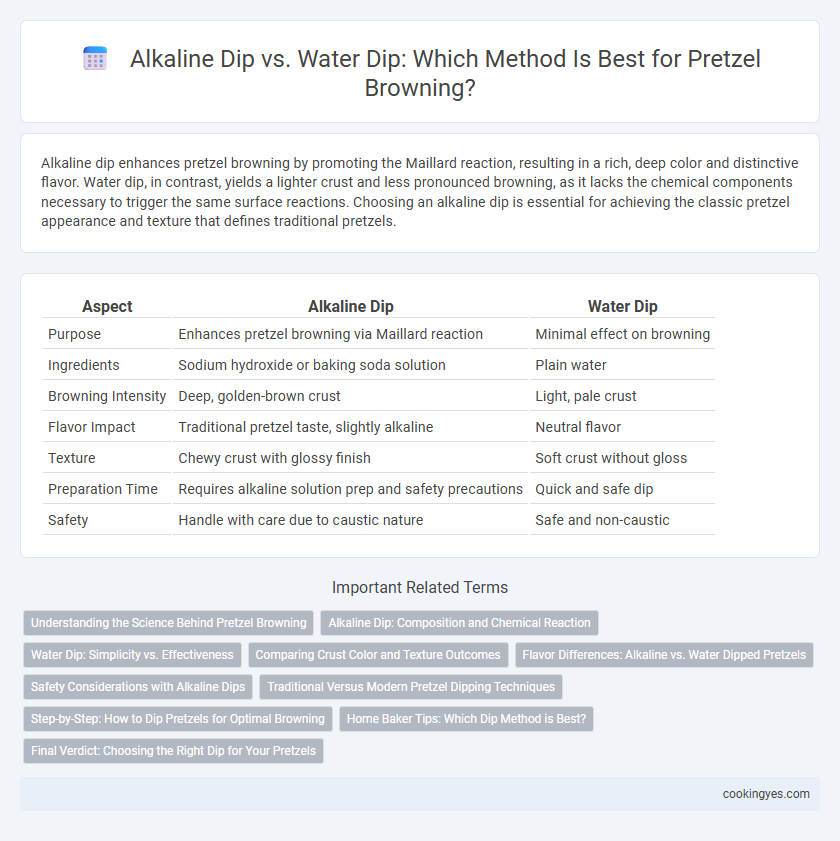Alkaline dip enhances pretzel browning by promoting the Maillard reaction, resulting in a rich, deep color and distinctive flavor. Water dip, in contrast, yields a lighter crust and less pronounced browning, as it lacks the chemical components necessary to trigger the same surface reactions. Choosing an alkaline dip is essential for achieving the classic pretzel appearance and texture that defines traditional pretzels.
Table of Comparison
| Aspect | Alkaline Dip | Water Dip |
|---|---|---|
| Purpose | Enhances pretzel browning via Maillard reaction | Minimal effect on browning |
| Ingredients | Sodium hydroxide or baking soda solution | Plain water |
| Browning Intensity | Deep, golden-brown crust | Light, pale crust |
| Flavor Impact | Traditional pretzel taste, slightly alkaline | Neutral flavor |
| Texture | Chewy crust with glossy finish | Soft crust without gloss |
| Preparation Time | Requires alkaline solution prep and safety precautions | Quick and safe dip |
| Safety | Handle with care due to caustic nature | Safe and non-caustic |
Understanding the Science Behind Pretzel Browning
Pretzel browning primarily results from the Maillard reaction, a chemical interaction between amino acids and reducing sugars, enhanced by alkaline conditions. Alkaline dips, typically using sodium hydroxide or baking soda, increase surface pH, accelerating this browning process and producing the characteristic deep brown, glossy crust of traditional pretzels. In contrast, water dips do not alter surface pH significantly, resulting in less intense browning and a softer crust texture.
Alkaline Dip: Composition and Chemical Reaction
The alkaline dip for pretzel browning primarily consists of a lye solution, typically sodium hydroxide (NaOH) at concentrations around 3-4%, which creates an alkaline environment essential for the Maillard reaction. This chemical reaction between amino acids and reducing sugars on the pretzel surface produces the characteristic deep brown color and distinctive flavor. The alkaline pH also gelatinizes the surface starches, enhancing the pretzel's glossy appearance and chewy texture, effects that a simple water dip cannot achieve.
Water Dip: Simplicity vs. Effectiveness
Water dip for pretzel browning offers a simple and safe method, relying on steam generated during baking to achieve a light golden crust. While it lacks the strong Maillard reaction catalyzed by alkaline dips like lye or baking soda, water dip reduces chemical handling risks and simplifies preparation. This method suits artisan pretzels prioritizing natural textures and minimal processing over intense browning and distinctive flavor.
Comparing Crust Color and Texture Outcomes
Alkaline dip, typically using a lye solution, produces a distinctly darker, glossy crust with a chewy texture characteristic of traditional pretzels, while water dip results in a lighter, less crisp exterior. The Maillard reaction is significantly enhanced by alkaline conditions, intensifying crust browning and flavor development. Texture-wise, alkaline-dipped pretzels exhibit a firm, slightly crisp crust contrasted by the softer, pale crust from water-dipped pretzels.
Flavor Differences: Alkaline vs. Water Dipped Pretzels
Alkaline dip, typically a lye solution, creates a distinctive dark brown crust on pretzels by triggering the Maillard reaction, resulting in a rich, slightly tangy flavor with complex savory notes. Water-dipped pretzels develop a lighter, softer crust with a milder taste that lacks the characteristic deep flavor and chewiness of alkaline-treated dough. The choice between alkaline and water dips significantly influences pretzel browning and the overall sensory profile, making alkaline dips preferred for authentic pretzel flavor and texture.
Safety Considerations with Alkaline Dips
Alkaline dips, typically containing sodium hydroxide or potassium carbonate, enhance pretzel browning by promoting the Maillard reaction but pose significant safety hazards due to their caustic nature. Proper handling requires protective equipment such as gloves and eye protection, strict adherence to concentration guidelines, and well-ventilated preparation areas to prevent chemical burns and respiratory irritation. In contrast, water dips present fewer risks but result in less pronounced browning and flavor development, making safety a primary concern when choosing alkaline dips for pretzel preparation.
Traditional Versus Modern Pretzel Dipping Techniques
Traditional pretzel browning uses an alkaline dip, typically a sodium hydroxide or lye solution, to achieve a characteristic deep brown crust and distinctive flavor through the Maillard reaction. Modern pretzel techniques often prefer water dips, which produce a lighter crust and a softer texture, catering to contemporary consumer preferences for less intense flavors and safer handling. Alkaline dips ensure authentic pretzel qualities, while water dips offer an accessible alternative with subtle browning effects.
Step-by-Step: How to Dip Pretzels for Optimal Browning
For optimal pretzel browning, begin by preparing an alkaline dip using a 3-4% baking soda (sodium bicarbonate) solution heated to around 50-60degC, which promotes the Maillard reaction and creates the distinctive golden crust. Alternatively, a water dip lacks alkalinity and yields a lighter crust with less browning, making it less effective for authentic pretzel texture and flavor. Dip each pretzel for 10-20 seconds in the alkaline solution before baking to ensure even, dark, and crisp pretzel crust.
Home Baker Tips: Which Dip Method is Best?
Alkaline dip, typically a baking soda or lye solution, creates the classic deep brown crust and chewy texture by triggering the Maillard reaction more effectively than a simple water dip. Water dip may soften the pretzel's surface but lacks the chemical properties to develop the traditional rich color and distinctive savory flavor. Home bakers seeking authentic pretzel browning should opt for an alkaline dip to achieve optimal crust formation and that iconic golden-brown appearance.
Final Verdict: Choosing the Right Dip for Your Pretzels
Alkaline dip, typically a lye solution, enhances pretzel browning by promoting the Maillard reaction, resulting in the signature deep brown crust and rich flavor. Water dip offers a milder effect, producing a lighter color and subtler taste but still aiding dough adherence and slight surface texture. For authentic pretzel browning and flavor, alkaline dip remains the preferred choice, while water dip suits those seeking a gentler crust or simpler preparation.
Alkaline dip vs Water dip for pretzel browning Infographic

 cookingyes.com
cookingyes.com